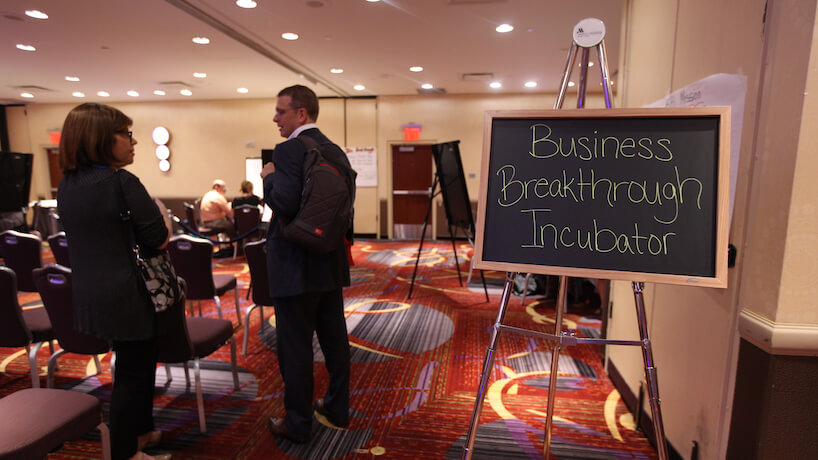Before a conference begins, most organizers have an understanding of all the outcomes. They’ve reviewed presentations, conducted speaker calls, and worked to outline the insights that attendees will take home. When the PCMA Education Conference kicked off in New York on June 10, though, one key component of the experience relied on not knowing answers. It was the organization’s first-ever Business Breakthrough Incubator, a one-day competition that pitted three teams against each other to solve a key challenge facing the industry: How can organizers build vibrant, high-sharing, and engaged communities within events that last long after attendees leave?
As 800 meeting professionals and suppliers arrived at the Marriott Marquis in New York for the opening-night festivities on Sunday, June 11, a small group of participants stepped away for a preview of the brainstorming battle set to take place two days later. “Each of the three teams had five strangers, most of whom didn’t know each other,” Donna Kastner, event marketing consultant at Enlighten 123 and facilitator for the Business Breakthrough Incubator, said in a recent interview. “We wanted to help everyone get together for a short 45-minute introduction and high-level overview to prepare them for the competition.”
While the participants weren’t surprised to be part of the competition — they had applied for the opportunity — they had been unaware of the specific challenge they needed to solve until they arrived. “We kept the challenge a secret so participants would have an even playing field, and no one would have the opportunity to work ahead of time,” said Kara Brockman, PCMA’s program manager, education. “The application provided us with important information to craft a challenge that was applicable to all.”
Timing Is Everything
Participants in the competition faced the tough task of figuring out a real formula for 365-day engagement, but they had an additional hurdle: time. The competition was divided into three one-hour chunks of time. “I almost felt like a running coach with a stop watch,” Kastner said. “Before each hour, we gathered for a five-minute meeting to give them direction on potential areas where they should focus and how far along they should be in developing their ideas.”
Kastner told PCMA that she thought dividing the brainstorming sessions into three installments was helpful. “I think the white space between each round gave participants time to think,” she said. “It’s important to give the brain a chance to rest and recharge. If we would have asked them to devote three consecutive hours to the process, I worry they would have been exhausted by the end.”
In addition to finding their own time to think, the space between sessions offered some surprise help. After the first hour, Kastner advised everyone to pitch portions of their ideas to conference attendees in the Connect area, the nearby open-space learning and networking lounge. After the second hour, she offered a bonus: the opportunity to recruit one additional person to each team. “These surprises provided a great way to continue elevating the competition,” Kastner said. “The extra sets of eyes played an important role in the final round of development, too.”
The incubator closed with the big moment — a chance for a spokesperson from each team to pitch their ideas to the entire conference in the general session environment. “Since these individuals had applied to be part of the competition, they were braver than the average bear,” Kastner said. “Still, some of them weren’t accustomed to presenting to big audiences. So I was extremely impressed with everyone’s ability to feel comfortable on the big stage.”
Creating a Competition At Your Conference
The business-events industry isn’t alone in the need for creative solutions to address pressing issues. Kastner highlighted that this type of competition can work for any type of audience. From physicians working to address challenges in the patient-care environment to educators aiming to develop ideas for more effective classrooms and more, other conferences can establish similar incubator-style friendly competitions. “Think about your audience, and adjust accordingly,” Kastner said. “You need to prepare as much as you can, but you’ll also need to be nimble to respond to unexpected challenges that can arise.”
Interested in learning how Kastner and PCMA addressed their own unexpected challenges? Complete the form below to download the case study from the competition.

